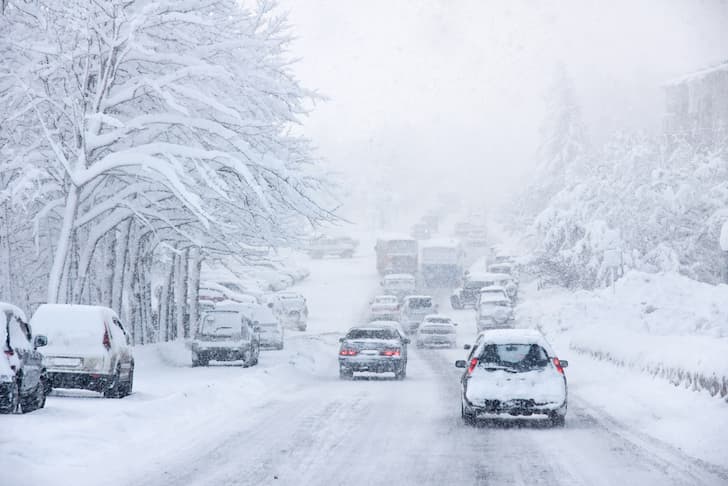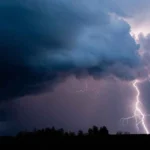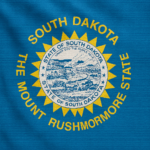
A blizzard is a severe snowstorm that is characterized by strong winds of at least 35 miles per hour and low visibility of less than a quarter of a mile. The combination of heavy snowfall and high winds can create dangerous conditions, making travel impossible and disrupting daily life. The winds in a blizzard can create snowdrifts that are several feet high, making it difficult to clear roads and sidewalks.
The Iran Blizzard of 1972 is one of the deadliest blizzards in recorded history, with an estimated death toll of 4,000 people. The blizzard struck Iran on February 3, 1972, and lasted for several days, covering the country in several feet of snow. The extreme cold and heavy snowfall made it difficult for rescue workers to reach affected areas, leading to many deaths.
The largest snowflake ever recorded was 15 inches in diameter and 8 inches thick. The snowflake was reported in Fort Keogh, Montana, in 1887 and was recorded in the Guinness Book of World Records. Snowflakes can form in a variety of shapes and sizes, depending on temperature and humidity conditions.
The 1993 Storm of the Century was a massive winter storm that affected over 26 states and caused over $6 billion in damages. The storm began on March 12, 1993, and lasted for several days, bringing heavy snowfall, high winds, and severe weather conditions. The storm disrupted air travel, closed roads and schools, and left millions without power for days. The storm is one of the most significant weather events in modern history.
The term “blizzard” was first used to describe a snowstorm in Iowa in the 1870s. The term was originally used by newspaper reporters to describe a severe snowstorm that hit the state, and the term quickly caught on. Today, the term “blizzard” is used to describe a severe snowstorm that is characterized by strong winds and low visibility.
The Great Blizzard of 1888 is one of the most significant blizzards in American history, with snowfall reaching up to 50 inches in some areas. The storm hit the northeastern United States and caused widespread damage and loss of life. The storm disrupted transportation and communication, making it difficult for rescue workers to reach affected areas. The storm is still remembered today as one of the worst blizzards in American history.
The Blizzard of 1978 was a severe winter storm that paralyzed the northeastern United States and resulted in over 100 deaths. The storm brought heavy snowfall and high winds, creating dangerous conditions for travel and daily life. The storm caused significant damage to infrastructure, and many cities and towns were without power for several days.
Blizzards in Antarctica can be particularly severe, with winds reaching up to 200 mph. The extreme cold and high winds can create dangerous conditions, making it difficult for researchers and workers to operate in the region. The harsh weather conditions in Antarctica can pose significant challenges for those who work and live there.
The Great Blizzard of 1899 brought snow and freezing temperatures to Florida, causing significant damage to crops and livestock. The storm is one of the most significant weather events in Florida history, and it is still remembered today for its devastating impact on the state’s agriculture industry. The storm caused significant economic losses and left many residents without food or shelter.
The blizzard of 2015, also known as “Snowmageddon,” brought up to three feet of snow to parts of the northeastern United States. The storm caused significant disruptions to transportation and daily life, and many cities and towns were forced to close schools and businesses. The storm caused millions of dollars in damages and left many residents without power for several days. The storm also resulted in several fatalities, including some due to carbon monoxide poisoning from improper use of heating sources.
In 1977, a series of blizzards hit western New York, leading to what is known as the “Blizzard of ’77.” The storms brought heavy snowfall and high winds, creating snowdrifts that were as high as two-story buildings. The blizzards caused significant damage to infrastructure, and many residents were stranded without food or power for several days.
In 2006, a blizzard struck the eastern coast of the United States, leading to significant disruptions to air travel. The storm, which was dubbed the “Valentine’s Day Storm,” caused several airports to close, stranding thousands of passengers. The storm also caused significant damage to infrastructure and resulted in several fatalities.
The Blizzard of 1967, also known as the “Chicago Blizzard,” was one of the worst blizzards in American history. The storm brought heavy snowfall and high winds to the city of Chicago, creating snowdrifts that were as high as 10 feet. The storm caused significant damage to infrastructure, and many residents were without power for several days.
The Great Appalachian Storm of 1950 was a severe winter storm that affected the eastern United States, causing significant damage and loss of life. The storm brought heavy snowfall and high winds, creating dangerous conditions for travel and daily life. The storm caused significant damage to infrastructure, including bridges and power lines.
Blizzards can occur in other parts of the world besides North America. In 2008, a blizzard hit China, causing significant disruptions to transportation and daily life. The storm resulted in several fatalities and left many residents without power or access to food and water.
In 2010, a blizzard struck the United Kingdom, leading to significant disruptions to transportation and daily life. The storm brought heavy snowfall and high winds, causing several airports to close and leading to the cancellation of many flights. The storm also caused significant damage to infrastructure, including power lines and roads.
The blizzard of 1971, also known as the “Alaskan Storm,” was a severe winter storm that affected Alaska and the Yukon Territory in Canada. The storm brought heavy snowfall and high winds, creating dangerous conditions for travel and daily life. The storm caused significant damage to infrastructure and resulted in several fatalities.
Blizzards can have a significant impact on wildlife. During a blizzard, animals may struggle to find food and shelter, leading to increased mortality rates. In some cases, blizzards can also impact migration patterns and reproductive cycles of wildlife.
The Blizzard of 2018, also known as the “Bomb Cyclone,” hit the northeastern United States and brought heavy snowfall and high winds. The storm caused significant disruptions to transportation, including the cancellation of thousands of flights. The storm also caused significant damage to infrastructure, including power lines and roads.
The Snowmageddon blizzard of 2010 hit the Washington, D.C. area, leading to significant disruptions to daily life and transportation. The storm brought heavy snowfall and high winds, causing several airports to close and leading to the cancellation of many flights. The storm also caused significant damage to infrastructure, including power lines and roads.
In 1996, a blizzard hit the eastern United States, leading to significant disruptions to transportation and daily life. The storm brought heavy snowfall and high winds, causing several airports to close and leading to the cancellation of many flights. The storm also caused significant damage to infrastructure, including power lines and roads.
The 2019 Bomb Cyclone brought heavy snowfall and high winds to the central United States, leading to significant disruptions to transportation and daily life. The storm caused widespread power outages and resulted in several fatalities. Many residents were stranded without access to food, water, or medical supplies.
Blizzards can also have economic impacts. The cost of damages and lost productivity during and after a blizzard can be significant. For example, the Blizzard of 1993 in the eastern United States resulted in an estimated $6.6 billion in damages and lost productivity. The economic impact of blizzards can be particularly severe in areas that are not accustomed to such storms and do not have the necessary infrastructure to handle them.
Frequently Asked Questions About Blizzards
Blizzards are powerful winter storms that can bring dangerous conditions. Here are some FAQs to help you understand them better:
1. What is a blizzard?
The National Weather Service defines a blizzard as a winter storm with three key features that must occur simultaneously for at least three hours:
- Sustained winds: Winds exceeding 35 mph (56 km/h)
- Significant snowfall or blowing snow: Reducing visibility to less than ¼ mile (0.4 km)
- Low temperatures: Generally below 10°F (-12°C)
2. What causes blizzards?
Blizzards form when cold air masses collide with warm, moist air masses. The moisture condenses rapidly, forming heavy snowfall. Strong winds pick up the falling and accumulated snow, reducing visibility significantly. These conditions combine to create a dangerous winter storm.
3. Are there different types of blizzards?
- Ground blizzards: These occur in areas with existing snow cover. Strong winds blow loose snow horizontally, creating blizzard conditions even without new snowfall.
- Whiteouts: While not technically a blizzard, a whiteout is a dangerous condition where blowing snow or falling snow drastically reduces visibility to near zero. This can occur during blizzards or other winter storms.
4. What are the dangers of blizzards?
Blizzards pose several dangers:
- Reduced visibility: Limited visibility makes driving and navigating extremely hazardous.
- Extreme cold: Blizzards bring dangerously low wind chills that can lead to frostbite and hypothermia.
- Heavy snowfall: Accumulating snow can create dangerous roof loads on buildings, disrupt travel, and make it difficult to move around.
- Power outages: Blizzards can damage power lines, leading to widespread outages and disruptions.
5. How can I prepare for a blizzard?
Here are some steps to take to prepare for a blizzard:
- Stay informed: Monitor weather forecasts and warnings issued by the National Weather Service.
- Stock up on supplies: Have a non-perishable food and water supply for at least three days, along with medications, first-aid supplies, and essentials like batteries and flashlights.
- Prepare your home: Insulate windows and doors, ensure your heating system is functioning properly, and have alternative heating options available in case of power outages.
- Assemble a winter emergency kit: Include warm clothing, blankets, boots, a battery-powered radio, and a cell phone charger.
- Prepare your car: If you must travel, ensure your car is winterized with proper tires, antifreeze, and an emergency kit.
- Develop a communication plan: Have a way to communicate with family members and stay informed about storm updates.
6. What should I do during a blizzard?
- Stay indoors: Avoid unnecessary travel during a blizzard. If you must go out, dress warmly in layers and take precautions against the cold.
- Stay informed: Monitor weather updates and follow instructions from emergency officials.
- Conserve heat: Dress warmly indoors, minimize opening doors and windows, and use alternative heating sources if necessary during power outages.
- Stay hydrated: Drink plenty of fluids to avoid dehydration.
7. What should I do after a blizzard?
- Stay informed: Continue to monitor weather updates for warnings and road closure information.
- Check on others: Help neighbors and those who may be vulnerable, especially the elderly or those living alone.
- Avoid driving: Roads may be icy and dangerous. Only travel if absolutely necessary.
- Clear snow: If safe to do so, remove snow from around your home to prevent damage from melting snow.
By understanding blizzards and taking proper precautions, you can stay safe and prepared during these powerful winter storms.








